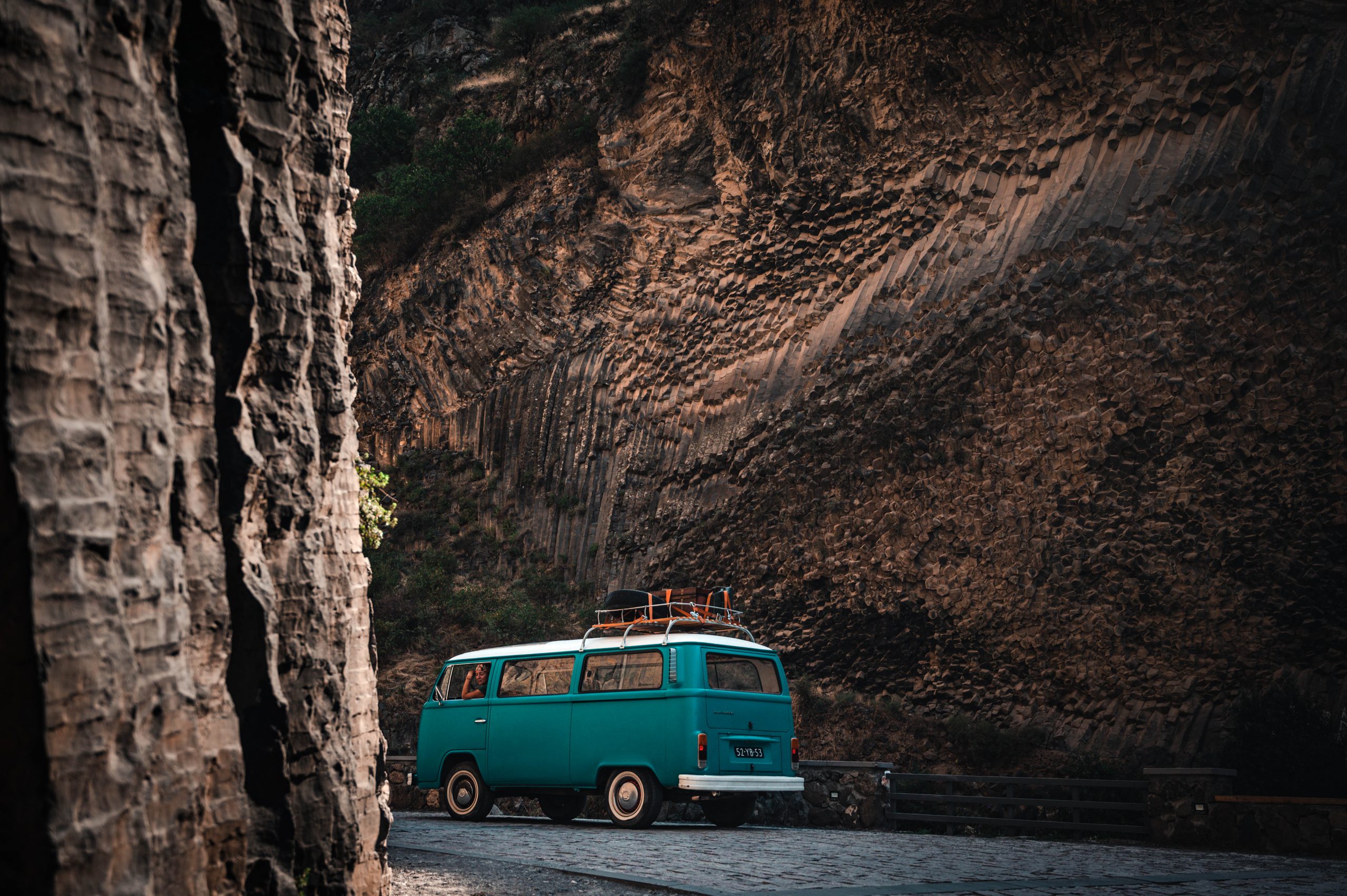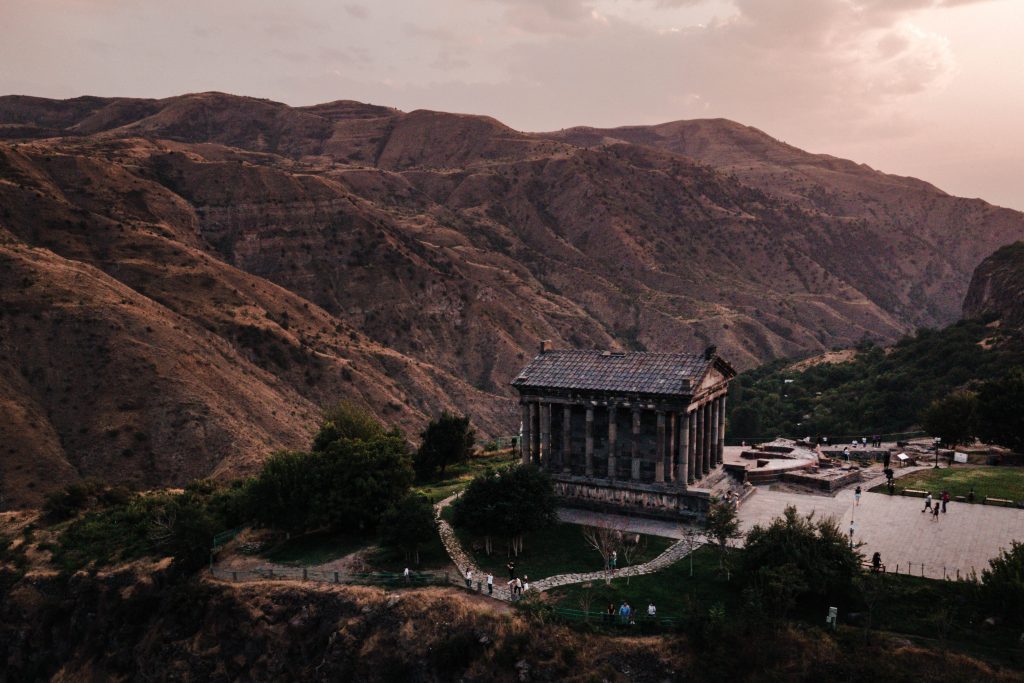Finally exploring again. We love visiting cities and staying in a hotel, guesthouse, airbnb for a while but we love it even more to explore the roads with Alexine and drive towards unknown destinations. Not knowing where we will sleep that night, but enjoying the wind rushing through the van, while Alexine crosses mountains.
The only Pagan Temple of Armenia
This time we wouldn’t drive too far. Armenia is small so most places are not that far from each other, which we like and Alexine even more. It means she doesn’t heath up too much. Anyway, after 50 minutes we arrived in Garni. Famous for the Pagan Temple and the Symphony of Stones. We visited both, but first the Pagan Temple.
The Garni Pagan Temple was once a pagan temple dedicated to the Armenian sun god Mihr. Built in the middle of the 1st century CE, the Temple of Garni remarkably survived the destruction of pagan temples following Armenia’s conversion to Christianity in the 4th century CE, and countless invasions and earthquakes until its collapse in 1679 CE.
Today, it is the only free-standing Greco-Roman structure in Armenia and seen by many as a potent symbol of Armenia’s classical past as well as its deep historical ties to the civilizations of Greece and Rome. We love when histories of different countries come together in yet another country.
The Temple of Garni is situated in a very strategic location, on a cliff, overlooking a range of the Geghama mountains as well as the Azat River (meaning; freedom river) near the Ararat Plain. The site was inhabited in prehistoric times, and there is evidence that it was also used by the Urartians between the 8th-6th centuries BCE.
A very nice place to visit, although also very crowded with people not interested in all of the above. They are mainly visiting to take a selfie in various positions. Along our trip we’ve seen so many people being more occupied with themselves by taking selfies all the time, in various positions, than absorbing the stories, the culture and the incredible architecture of a place like this. The Pagan temple was not any different from a bridge in Rome or a Svan tower in Ushguli. It’s annoying, yet understanding. The time we are living in is all about individualism, social media is built on it. A selfie on Instagram gets a lot more likes due to the algorithm than a beautiful photo of the temple without persons in it. Sad, but true.
Thus, after getting a bit annoyed but the selfie bombs of people we decided it was time to move on.
Symphony of Stones
Not far from the village Garni we found one of the most well-known and beautiful natural monuments of Armenia: Symphony of Stones. It is said, like the Giant’s Causeway in Ireland & Scotland, that this natural monument is the result of the collapse of the volcanic rocks. And yeah, it looks very similar. Though the difference is the amount. The whole Garni Gorge is filled with these volcanic rocks.
The basalt columns (some nearly 50 meters high) hang against gravity of which some resemble an organ; thus, symphony of stones. We decided this was a good place to park the van, have diner and watch the stars, of which there were many. The moon shone on the symphony and while the last picnic group was gone silence returned. Except for the river and birds of pray flying over.
Visiting Geghard Monastery, UNESCO sight
After a very good night sleep we headed towards another monastery and several churches. It would also be the day that we visited a UNESCO sight, and ate one!
The monastery of Geghard contains a number of churches and tombs, most of them cut into the rock, which illustrate the very peak of Armenian medieval architecture. The complex of medieval buildings is set into a landscape of great natural beauty, surrounded by towering cliffs at the entrance to the Azat Valley. – UNESCO
Read more about the monastery via the link above. It was quite busy when we got here but it was doable. So, the first church we visited is the main church. Upon entering we found that the church is built upon a spring. Of course, many then think it’s holy water but it didn’t taste any different than mountain water so that’s debatable. Anyway, there were some people taking it very serious. One lady was standing at the foot of the spring, mumbling some words and making a cross on her chest without stopping. We went to check all the other rooms, went outside to check some thumbs, even went to visit one other church before coming back to see what was happening inside the spring room. She was still standing there, making crosses and mumbling words. You gotta love the dedication. She did get angry at other people filling their water bottles with holy mountain spring water.
However, the real gem of Geghard is not actually the biggest church but the one on top of it. While entering there a man was singing. Not quietly, not in himself but out loud. It filled the church with his voice and the echo and gave me a chill down my spine. I, Milene, was alone with this man and I almost felt a bit spiritual, which I’m truly not. You understand that when he left and Yuri arrived, he took his place. Not singing like him but humming. It sounded even better! I love it when places are built to make sounds become music and when the voices are magnified so that everyone listens. Even though one cannot understand.
After our private concert we left. We climbed up a little bit to an old church cut in the mountain and left right after it.
On the way to a campsite (yep!) we saw ladies baking bread. Not just any bread but Lavash!!
Finally eating UNESCO bread: Lavash
Lavash is a soft and flat bread that can be folded easily to make sandwiches and wraps. It’s popular in countries such as Armenia, Iran, Azerbaijan and Turkey. Traditionally, lavash is made in tanoor (brick or wood oven) or on saj Tava. Lavash can be preserved for about 6 months. The ladies showed us how they make the bread. Let’s share it:
A simple dough made of wheat flour and water is kneaded and formed into balls, which are then rolled into thin layers and stretched over a special oval cushion that is then slapped against the wall of a traditional conical clay oven. After thirty seconds to a minute, the baked bread is pulled from the oven wall.
Of course we bought some of the bread and tasted it, delicious! It’s not that different from Turkish, Iranian or other Middle Eastern bread but it’s Unesco so it’s cool.
Lavash is included in UNESCO Representative List of Intangible Cultural Heritage of Humanity. The nomination was submitted by The Ministry of Culture of the Republic of Armenia and the Ministry of Foreign Affairs of the Republic of Armenia in 2013. “Lavash, the preparation, meaning and appearance of traditional bread as an expression of culture in Armenia”.
With UNESCO bread in our pocket we knocked on the door of Campsite 3Gs. On Instagram many people told us we should go here so why ask if you don’t listen right? Thus, we arrived here and were welcomed by Sandra, one of the owners. Sandra and her husband Marty are from The Netherlands and started the campsite in 2015. They call it campsite, we think it’s more a combination of glamping, camping & b&b. And that’s exactly what it is. With two kitchens, three toilets, showers, a washing machine and wonderful swimming pool this place has it all. We will stay here a couple of nights to relax, do some work and plan the rest of our trip because if Iran doesn’t open it’s borders and other borders might close we have to consider different options.
What do you think we should do?
Love, Milene & Yuri







